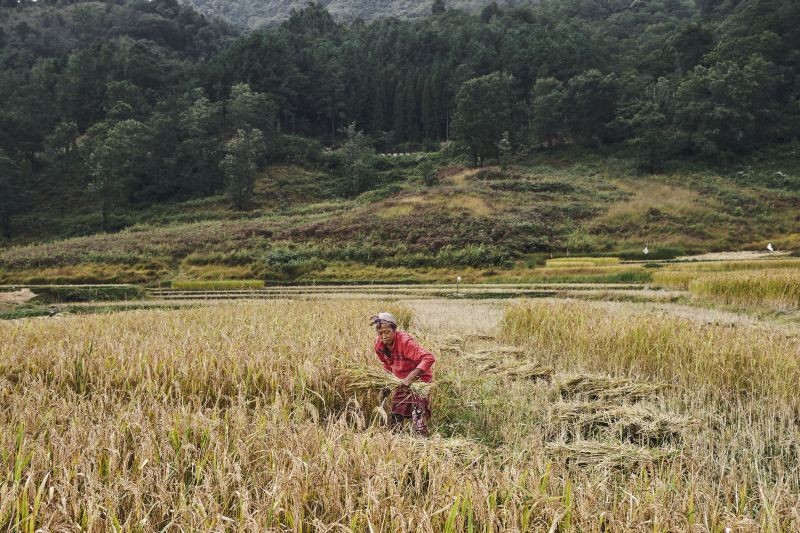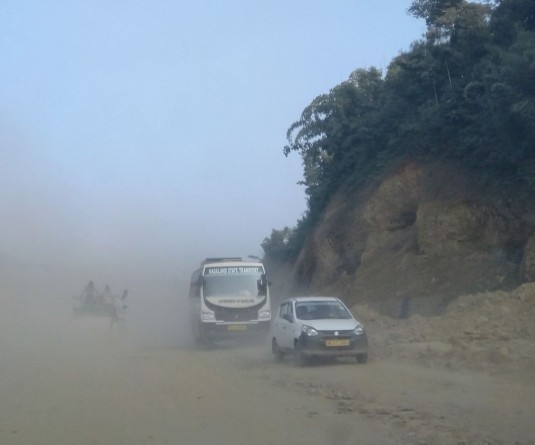A Naga woman harvesting a paddy field. Despite being an agrarian society, Nagaland still has ways to go to fulfill its potential for food self sufficiency. (Photo Courtesy: Zhazo Miachieo/Photo Journalist)
.jpg)
.jpg)

Atono Tsükrü Kense
Kohima | December 4
Against the backdrop of the COVID-19 pandemic which has severely impacted the already resource deficit state of Nagaland, the State Government has been emphasising on ‘self-reliance’ in the agri-allied sector to intensify crop cultivation and increase production to face the challenges of food crisis.
Basically, Nagaland is an agrarian state. Agriculture has been the main source of livelihood and occupation of their forefathers. However, with modernisation, people have slowly moved to ‘white-collar’ jobs.
Blessed with conducive climate and fertile soil, Nagaland has the potential to achieve food self-sufficiency, if not 100%, at least 40-50% of what people consume on a daily basis. The State however is presently importing food grains and vegetables, many of inferior quality compared to what can be produced here.
Speaking to The Morung Express, Professor Sapu Changkija, who teaches at the School of Agriculture Sciences and Rural Development, shared his views on ways the State can achieve self sufficiency. Changkija is an experienced researcher in this field with works published in national and international journals.
Nagaland’s prospects
Prof. Changkija said environmentally Nagaland is bestowed with almost all the environmental factors for potential to achieve self sufficiency.
“Nagaland has abundant rainfall with unique and rich forest types representing very rich vegetations with rich biodiversity. Soil types are with variant structure forms and in general soil is fertile. The unique forest systems with well stratified vegetation forms rich soil, supported by its rich sedimentary mother rock formations which release the macro and micro nutrients into the soil forming rich habitat to grow almost all crops in the state” he added.
Prof. Changkija said “our state has the prospective towards ‘self-reliance’ on agri-allied sector, as Nagaland has a small population with a suitable cultivable sloping land.”
He pointed out that compared to other states Nagaland has more than 85% areas cultivable and about 15% are occupied (urban areas) whereby only about 10% may not be cultivated due to rocky gorges. “There is no uncultivable land in the state, therefore keeping about 30 – 40% reserved for forest land, community can utilize the remaining land mass for self-reliance on agri-allied sectors” said Changkija.
Experts, scientists not doing enough
Changkija however felt that agri experts and scientists are not doing enough towards aiding farmers and the government, often leading to wrong policies and programmes due to ignorance and lack of proper studies on scientific researches based on climatic conditions and without proper analysis on its environmental factors.
He called for urgent efforts to take up proper experimental research projects based on genetics and plant breeding programmes. This, he said, needs to be done “before our valuable germplasm are lost forever.” In this, he informed that “many of our rice landraces documented cannot be traced since a few decades in our state.”
“By tradition, Naga farmers use very few simple indigenous farming tools, in which Naga engineers can try to improvise to simple mechanization and automation suitable for our hill farming system” maintained Changkija.
He also said that blending traditional knowledge systems with the formal systems can help evolve methods for adoption by local farmers.
Suitable crops for mass production
Nagaland, he pointed has the richest cereal germplasm in the world with varieties of rich indigenous nutritional rice (White, creamy, brown, red, pink, green, glutinous, large grains, small grains, slender, bold etc are all grown as staple food). The secondary staple food of many varieties of indigenous millet, sorghums, Job’s tears and various unique rich land races of maize are also available.
“All the endemic and indigenous crop varieties are hardy, resilient, more pest and disease resistant and all the above cereals and indigenous crops have international market demands as these quality crops don’t grow easily in the other parts of the world and can be produced in mass with the involvement of proper research” said Prof. Changkija.
Besides, he added that horti-allied crops such as coffee, areca nuts, jackfruits, cardamom, and temperate fruits also have potential for mass production.
No significant farm productions
“Statistically Nagaland has larger numbers of farmers,” Changkija pointed out. He however said that there is no significant farm production in the State, adding that even leafy vegetables in the market are coming from neighboring states.
Over the years, despite the numerous programmes being introduced by the government and the agri-allied departments, there has been no tangible outcome, he said. “Government may be spending lots of money in agri-allied sectors, yet often end up taking wrong decision and planning due to ignorance of proper studies on scientific researches,” he added.
Recommendations
To attaining self-reliance and increase production for export, Prof. Changkija recommended that the agri and allied departments take up thorough environmental and experimental based research in context to the local micro ecosystem conditions.
While asserting that study and researches have to be emphasised from the socio-economic point of view and based on suitability of farming systems, he urged the government to plan long term research and experiments based on fundamentals.
He meanwhile cautioned that unless the State produces and improves quality seed varieties suitable and adaptable to the local ecosystem conditions through proper research and experiment in the local environments, crop productions will not improve.






